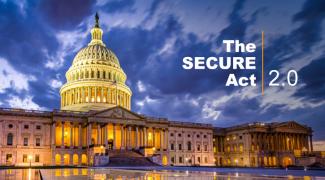
What is the SECURE Act 2.0?
Buried within the recently passed 4,000-page 2023 omnibus funding legislation was the Secure Act 2.0 which provides new and revised legislation that will affect many employer sponsored retirement plans and individual retirement accounts (IRAs). SECURE 2.0 (SECURE stands for Setting Every Community Up for Retirement Enhancement) was a follow-up legislation to the Secure Act signed into law by President Donald Trump on December 20, 2019. The SECURE Act(s) make numerous changes to both the Internal Revenue Code (IRC) and Employee Retirement Income Security Act (ERISA), which changes are intended to expand retirement plan coverage for workers and increase savings opportunities. The premise here is that in broadening Americans’ access to the retirement savings system it will make it much easier for participants of all demographics to save for their future. Some provisions of Act 2.0 will go into effect immediately, with others starting over the next few years. Here are some of the key provisions in this historic legislation affecting retirement saving.
RMDs – The Act increases the age of required minimum distributions (RMDs) in two phases: to age 73, starting immediately, and to age 75, starting in 2033. Individuals who turn 73 this year must take their first distribution no later than April 1, 2024, with subsequent year distributions by December 31st. Act 2.0 also reduces the tax penalty to 25%, from 50%, for any RMD shortfalls. The penalty can be further reduced to 10% if the account owner withdraws the RMD shortfall amount and submits a corrected tax return in a timely manner.
Automatic Plan Enrollment and Portability – SECURE 2.0 requires 401k and 403b plans to automatically enroll participants in their respective plans, effective for plan years beginning after December 31, 2024. The initial automatic enrollment amount must be at least 3%, but not more than 10% and must be increased in subsequent years by 1% up to a maximum of 15%. Plan participation is not mandatory as employees can easily opt-out. Automatic enrollment removes any active steps by the worker to participate and increases the likelihood of saving for retirement, particularly among younger, lower-paid workers. The Act also permits retirement plan providers to offer plan sponsors automatic account portability, transferring low balance accounts to a new plan when a worker changes jobs.
Higher Catch-up Contributions – The catch-up amount (age 50 and older) for 2023 will be $7,500, an increase of $1,000. Starting in 2025, individuals age 60 through 63 will be able to make catch-up contributions of up to $10,000 annually, and, in future years, that amount will be indexed to inflation.
Paying for College – Beginning in 2024, employers will be able to match employee student loan payments with matching contributions to a retirement account, encouraging workers to save while paying off education loans. For 529 plans, after 15 years, unused plan account assets can be rolled over to a Roth IRA for the beneficiary, subject to annual Roth contribution limits and a lifetime limit of $35,000.
Part-time Workers – Allows for part-time employees, who have worked at least 500 hours during each of two (decreased from 3 years in SECURE) consecutive 12-month periods, to be eligible to participate in 401(k) plans.
Emergency Savings – Plan sponsors can allow employees to set up a separate emergency savings account (annual contribution limit of $2,500) alongside their retirement accounts, thus encouraging saving for short-term and unexpected expenses. A second change allows plan participants to withdraw up to $1,000 (per year) to cover emergency expenses without incurring a penalty, however the employee would have to replace the withdrawn funds within three years before making another emergency withdrawal.

